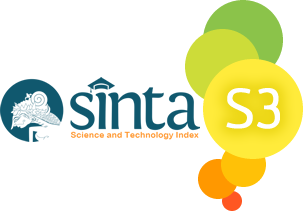EFEKTIFITAS BAKTERI ENDOFIT DAN PENAMBAHAN INDOLE ACETIC ACID (IAA) DALAM MENINGKATKAN PERTUMBUHAN TANAMAN PADI Oryza sativa L.
Abstrak
Rice plant needs essential and non-essential nutrients to grow. However, the use of inorganic fertilizers may affect the soil microbe community which expected to increase the availability of nutrients for both plants and microbes, a condition that could control several types of diseases. Many efforts were made to find alternative fertilizer which environmentally friendly, for instance by exploiting microorganisms such as endophytic bacteria associated with plant tissue or seed plant cell. This research aimed to determine the effect of endophytic bacteria, the concentration of IAA, and the combination of endophytic bacteria with a concentration of IAA, on the growth of rice plant. This research was conducted at the Laboratory of Soil Biology, The Soil Research Institute located in Cimanggu Bogor from December 2015 to February 2016. This research was a Completely Randomized Design (CRD) with two factors, i.e., the inoculant of endophytic bacteria (2.2 KT, KR 6, and I CM), and the concentration of IAA (0, 0.01, 0.1, 0.5, and 1 ppm). Three replicates were applied for each treatment of the inoculant combined with different doses of IAA. The variety of rice plants tested were Inpari 13 and IR 64. The potential test has been applied to determine the factor with the highest yield of the rice plant growth. The parameters observed were the height of the rice plant, the length of the rice plant roots, and the total weight of the plant including root. The results showed the inocula of endophytic bacteria alone had no effect to increase growth for both IR 64 and Inpari 13 rice variety. The IAA concentration of 0.1 ppm was able to increase the height of rice plant and the length of rice plant root for both IR 64 rice plant and Inpari 13. The combined treatment of KR 6 bacterial inoculum with 1 ppm of IAA concentration was effectively promoted rice plant growth for both IR 64 and Inpari 13.
Kata Kunci
Teks Lengkap:
PDFReferensi
Backman PA, Sikora RA. 2008. Endophytes: An emerging tool for biological control. Biol. Control. 46(1): 1-3. https://doi.org/10.1016/j.biocontrol.2008.03.009
Dewi IR. 2008. Peranan dan fungsi fitohormon bagi pertumbuhan tanaman [skripsi]. Bandung: Universitas Padjajaran.
Fuchs HWM. 1986. Root regeneration of rose plants as influenced by applied auxins. Acta Horticulture. 189: 101-107. https://doi.org/10.17660/ActaHortic.1986.189.11
George EF, Sherington PD. 1984. Plant propagation by tissue culture, Handbook and Directory of Comercial Laboratories. England: Exegetics Ltd.
Goldsworthy RP, Fisher NM. 1996. Fisiologi tanaman budidaya tropik. Yogyakarta: Universitas Gadjah Mada.
Hallmann J, Quadt-Hallmann A, Mahaffee WF, Kloepper JW. 1997. Bacterial endophytes in agricultural crops. Can. J. Microbiol. 43(10): 895-914. https://doi.org/10.1139/m97-131
Hallmann J. 2001. Plant interaction with endophytic bacteria. In: Jeger, M. J., Spence, N. J. (ed). Biotic Interaction in Plant-Pathogen Associations. CAB International. p 87-119. https://doi.org/10.1079/9780851995120.0087
Haryadi SS, Yahya S. 1988. Fisiologi stres lingkungan. Bogor: PAU Bioteknologi IPB.
Hendriyani IS, Setiari N. 2009. Kandungan klorofil dan pertumbuhan kacang panjang (Vigna sinensis) pada tingkat penyediaan air yang berbeda. J. Sains & Mat. 17(3): 145-150.
Husein E, Saraswati R, Hastuti RD. 2008. Rizobakteri pemacu tumbuh tanaman. Dalam buku: Metode analisis biologi tanah. Bogor: Balai Besar Penelitian dan Pengembangan Sumberdaya Lahan Pertanian. p 191-209
Ismunadji M, Dijkshoorn W. 1971. Nitrogen nutrition of rice plants measured by growth and nutrient content in pot experiment. I. Ionic balance and selective uptake. J Agr Sci. 19: 223-236.
Lestari P, Susilowati DN, Riyanti EI. 2007. Pengaruh hormon asam indol asetat yang dihasilkan Azospirillum sp. terhadap perkembangan akar padi. Jurnal AgroBiogen. 3(2): 66-72. https://doi.org/10.21082/jbio.v3n2.2007.p66-72
Leveau JHJ, Lindow SE. 2005. Utilization of plant hormone indole-3-acetic acid for growth by Pseudomonas putida strain 1290. Appl Environ Microbiol. 71(5): 2365-2371. https://doi.org/10.1128/AEM.71.5.2365-2371.2005
Lugtenberg BJJ, Kravchenko LV, Simons M. 1999. Tomato seeds and root exudates sugars: composition, utilization by Pseudomonas biocontrol strains and role in rhizosphere colonization. Environ.Microbiol. 1:439-445. https://doi.org/10.1046/j.1462-2920.1999.00054.x
Maftuchah, Slamet-Loedin IH, Aswidinnor SH. 2000. Induksi tunas dari kalus embriogenik padi Cisadane dalam berbagai konsentrasi IAA dan BAP. Prosiding Seminar Nasional Bioteknologi Pertanian; 7-9 November 2000; Yogyakarta. Yogyakarta: Perhimpunan Bioteknologi Pertanian Indonesia; p.134-140.
Munarti, Kurniasih S. 2014. Pengaruh konsentrasi IAA dan BAP terhadap pertumbuhan stek mikro kentang secara in vitro. Jurnal Pendidikan Biologi, FKIP, Universitas Pakuan Vol 1. Bogor.
Palupi ER, Dedywiryanto Y. 2008. Kajian karakter toleransi cekaman kekeringan pada empat genotipe bibit kelapa sawit (Elaeis guineensis Jacq). Bul. Agron. 36(1): 24-32.
Prawiranata W, Harran S, Tjondronegoro P. 1988. Dasar-dasar fisiologi tumbuhan. Bogor: Departemen Botani Fakultas Pertanian IPB.
Sarief ES. 1986. Kesuburan dan pemupukan tanah pertanian. Bandung: Pustaka Buana.
Singh CS, Subba-Rao S. 1979. Associative effect of Azospirillum brasilense with Rhizobium japonicum on nodulation and yield of soybean (Glysine max). Plant Soil 53(3): 387-392. https://doi.org/10.1007/BF02277872
Spaepen S, Vanderleyden J, Remans R. 2007. Indole-3-acetic acid in microbial and microorganism plant signaling. FEMS Microbiol Rev. 31(4): 425-448.
https://doi.org/10.1111/j.1574-6976.2007.00072.x
Sylvia D, Fuhrmann J, Hartel P, Zuberer D. 2005. Principles and applications of soil microbiology. New Jersey: Pearson Education Inc.
Article Reads
Total: 2839 Abstrak: 1786 PDF: 1053Refbacks
- Saat ini tidak ada refbacks.

This work is licensed under a Creative Commons Attribution-ShareAlike 4.0 International License.
This website is maintained by:
Bio Publisher
The Faculty of Biology Publishing
Laman ini dikelola oleh:
Penerbitan Fakultas Biologi
Universitas Jenderal Soedirman
Jalan dr. Suparno 63 Grendeng
Purwokerto 53122
Telepon: +62-281-625865
Email: biologi@unsoed.ac.id
Laman ini menggunakan:
OJS | Open Journal System
Software pengelolaan jurnal ilmiah online. Versi yang digunakan adalah 2.4.8.0.
Metadata artikel terdaftar di:
Crossref
Agen resmi internasional pendaftaran Digital Object Identifier (DOI)
Artikel jurnal ini terindeks:








